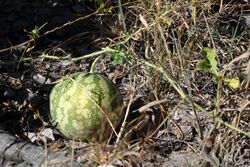Biology:Citrullus ecirrhosus
| Citrullus ecirrhosus | |
|---|---|

| |
| Scientific classification | |
| Kingdom: | Plantae |
| Clade: | Tracheophytes |
| Clade: | Angiosperms |
| Clade: | Eudicots |
| Clade: | Rosids |
| Order: | Cucurbitales |
| Family: | Cucurbitaceae |
| Genus: | Citrullus |
| Species: | C. ecirrhosus
|
| Binomial name | |
| Citrullus ecirrhosus Cogn. 1888
| |
| Synonyms[1] | |
| |
Citrullus ecirrhosus, commonly known as Namib tsamma, is a species of perennial desert vine in the gourd family, Cucurbitaceae, and a relative of the widely consumed watermelon (Citrullus lanatus). It can be found in both Namibia and South Africa , in particular the Namib Desert. It is the sister species to the bitter melon, Citrullus amarus with which it shares hard, white and bitter flesh.[2]
The vines can crawl for up to two meters, and it has yellow flowers. As a desert plant, it is a hardy species, surviving with little water and strong sunlight. The leaves form annual stems which die back each year. The plant relies on water deep in the ground and morning fogs. It is an important source of water for numerous desert fauna. The bitter-tasting fruit it produces are known as tsamma melons.
Experiments done by Simmons, Jarret, Cantrell, and Amnon in 2019 introduced the hybridization of Citrullus ecirrhosus and Citrullus lanatus developed a cultivated watermelon capable of resistance to pests such as whiteflies (Bemisia tabaci).[3] The hybrid developed whitefly resistance while still retaining traits of watermelon (Citrullus lanatus). While the hybrid did not offer total resistance, it was better protected than regular grown watermelons.
References
- ↑ "The Plant List: A Working List of All Plant Species". http://www.theplantlist.org/tpl1.1/record/kew-2723904. Retrieved 8 October 2014.
- ↑ Chomicki, G.; S. S. Renner (2015). "Watermelon origin solved with molecular phylogenetics including Linnaean material: another example of museomics". New Phytologist 205 (2): 526–532. doi:10.1111/nph.13163. PMID 25358433.
- ↑ Simmons, A. M., Jarret, R. L., Cantrell, C. L., & Amnon, L. (2019, October). Citrullus ecirrhosus: Wild Source of Resistance Against Bemisia tabaci (Hemiptera: Aleyrodidae) for Cultivated Watermelon.
External links
Wikidata ☰ Q5122876 entry


